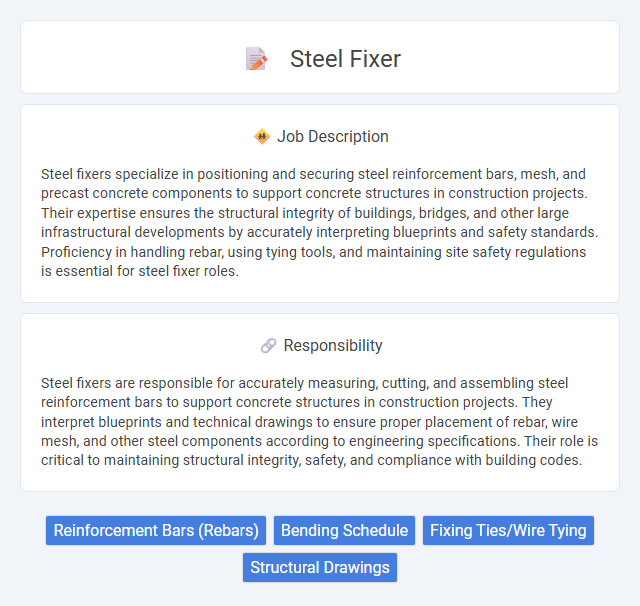
Steel fixers specialize in positioning and securing steel reinforcement bars, mesh, and precast concrete components to support concrete structures in construction projects. Their expertise ensures the structural integrity of buildings, bridges, and other large infrastructural developments by accurately interpreting blueprints and safety standards. Proficiency in handling rebar, using tying tools, and maintaining site safety regulations is essential for steel fixer roles.
Individuals with strong physical stamina and good manual dexterity are likely suitable for a steel fixer job, as the role often involves lifting heavy materials and precise placement of steel reinforcement. Those who can work comfortably at heights and in various weather conditions may find better compatibility with the job demands. People lacking physical fitness or who have difficulty with manual tasks might face challenges adapting to this occupation.
Qualification
Steel fixers require a solid understanding of construction blueprints and reinforcement techniques, typically gained through a combination of vocational training and on-the-job experience. Qualifications often include certifications in safety regulations, such as OSHA, and proficiency in handling steel bars and mesh for concrete reinforcement. Strong skills in measuring, cutting, and bending steel materials ensure accurate placement and structural integrity on construction sites.
Responsibility
Steel fixers are responsible for accurately measuring, cutting, and assembling steel reinforcement bars to support concrete structures in construction projects. They interpret blueprints and technical drawings to ensure proper placement of rebar, wire mesh, and other steel components according to engineering specifications. Their role is critical to maintaining structural integrity, safety, and compliance with building codes.
Benefit
Steel fixer jobs likely offer competitive wages and opportunities for overtime, contributing to a stable income. Benefits may include on-the-job training, enhancing skills that increase employability and career advancement potential. Job security is probable in this role due to ongoing demand in construction and infrastructure projects.
Challenge
Steel fixer jobs probably present significant physical and technical challenges due to the need for precise placement and installation of steel reinforcement bars within concrete structures. Workers likely face tight schedules and complex blueprints requiring strong spatial awareness and problem-solving skills. Safety risks may also be high, demanding rigorous adherence to safety protocols and continuous attention to detail.
Career Advancement
Steel fixers enhance construction projects by expertly positioning and securing steel reinforcements, a skill that leads to numerous career advancement opportunities in the construction industry. Gaining certifications such as welding or advanced metalwork, along with mastering blueprint reading and safety regulations, significantly increases a steel fixer's employability and potential for higher wages. Progression to supervisory roles or specialized fields like structural engineering technology often results from accumulated experience and continuous professional development.
Key Terms
Reinforcement Bars (Rebars)
Steel fixers specialize in positioning and securing reinforcement bars (rebars) to create the framework essential for concrete structures' strength and durability. They accurately measure, cut, bend, and tie rebars according to engineering blueprints, ensuring compliance with structural specifications and safety standards. Mastery of rebar placement directly influences the integrity and longevity of buildings, bridges, and other infrastructure projects.
Bending Schedule
A steel fixer plays a critical role in interpreting and implementing bending schedules to accurately cut, bend, and place steel reinforcement bars within concrete structures. The bending schedule provides precise measurements and angles, ensuring that steel supports meet design specifications for structural integrity. Expertise in reading these schedules directly impacts project quality, safety, and compliance with engineering standards.
Fixing Ties/Wire Tying
Steel fixers specialize in securing reinforcing bars (rebar) using ties and wire tying techniques to ensure structural integrity in concrete construction. Precise wire tying maintains proper spacing and alignment of steel bars, which is crucial for load distribution and preventing displacement during concrete pouring. Skilled use of tie wire tools and materials like annealed wire enables steel fixers to create strong, durable reinforcement frameworks that meet engineering specifications.
Structural Drawings
Steel fixers interpret structural drawings to accurately position and secure steel reinforcement bars essential for concrete construction. Proficiency in reading complex blueprints ensures compliance with engineering specifications and safety standards. Mastery of structural drawings directly impacts the integrity and durability of building frameworks.
 kuljobs.com
kuljobs.com